五种实现方式:
方式一:饿汉式
//饿汉式
public class Singleton1 implements Serializable {
private static final Singleton1 SINGLETON_TEST=new Singleton1();
//构造私有
private Singleton1() {
System.out.println("私有构造方法");
}
public static Singleton1 getInstance(){
return SINGLETON_TEST;
}
public static void otherMotherd(){
System.out.println("其他方法");
}
}
测试:
public class SingleTest {
public static void main(String[] args) {
Singleton1.otherMotherd();//检测是饿汉式
//私有构造方法
//其他方法
System.out.println(Singleton1.getInstance());//Singleton1@4d7e1886
System.out.println(Singleton1.getInstance());//Singleton1@4d7e1886
//以上两个实例为同一个对象
}
}
结果:
单例被破坏的情况:
-
序列化和反序列化:
当单例类实现了Serializable接口时,对象被序列化后再反序列化时会创建新的实例。为了避免这种情况,可以通过重写readResolve()方法来返回单例实例。
测试反序列化后的对象和原始对象是否一致:
/**
* 实现序列化接口后可能破坏单例模式
*/
@Test
void test5() throws Exception {
//将对象写入文件中
ObjectOutputStream oos=new ObjectOutputStream(new FileOutputStream("single1.ser"));
oos.writeObject(Singleton1.getInstance());
oos.close();
//从文件中读取对象
ObjectInputStream ois=new ObjectInputStream(new FileInputStream("single1.ser"));
Singleton1 single = (Singleton1) ois.readObject();
ois.close();
System.out.println("original:"+Singleton1.getInstance().hashCode());
System.out.println("DeSerializable:"+single.hashCode());
}结果: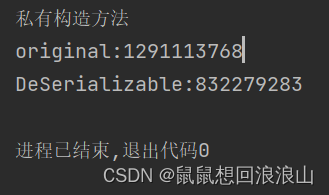

预防:
public class Singleton implements Serializable {
private static final Singleton instance = new Singleton();
private Singleton() {}
public static Singleton getInstance() {
return instance;
}
protected Object readResolve() {
return instance;
}
}
-
反射机制:
通过反射可以调用类的私有构造方法,从而创建多个实例。为了防止通过反射破坏单例模式,可以在构造方法中添加逻辑判断,确保只创建一个实例。
反射破坏单例:
@Test
void test() throws NoSuchMethodException, InvocationTargetException, InstantiationException, IllegalAccessException {
Singleton1 instance = Singleton1.getInstance();
Constructor<? extends Singleton1> constructor = instance.getClass().getDeclaredConstructor();
constructor.setAccessible(true);
Singleton1 singleton1 = constructor.newInstance();
System.out.println(instance==singleton1);
} 结果: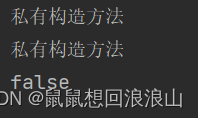
预防:在构造方法处进行判断
//饿汉式
public class Singleton2 implements Serializable {
private static final Singleton2 SINGLETON_TEST=new Singleton2();
//构造私有
private Singleton2() {
if (SINGLETON_TEST!=null){
throw new IllegalStateException("对象已经创建");
}
System.out.println("私有构造方法");
}
public static Singleton2 getInstance(){
return SINGLETON_TEST;
}
public static void otherMotherd(){
System.out.println("其他方法");
}
}以上防止反射破坏单例测试:
/**
*防止单例被破坏
*/
@Test
void test3() throws NoSuchMethodException, InvocationTargetException, InstantiationException, IllegalAccessException {
Singleton2 instance = Singleton2.getInstance();
Constructor<? extends Singleton2> constructor = instance.getClass().getDeclaredConstructor();
constructor.setAccessible(true);
Singleton2 singleton2 = constructor.newInstance();
System.out.println(instance==singleton2);
}结果:
-
类加载器:
如果使用不同的类加载器加载同一个类,也可能导致创建多个实例。为了解决这个问题,可以在获取实例时指定类加载器,确保只有一个实例被创建。
测试使用不同的类加载器导致同一个类创建多个实例的情况:
public static void main(String[] args) throws Exception {
CurstomLoader loader1=new CurstomLoader();
CurstomLoader loader2=new CurstomLoader();
Class<?> single1 = loader1.loadClass("com.example.singletonmodle.single.Singleton1");
Class<?> single2 = loader2.loadClass("com.example.singletonmodle.single.Singleton1");
Singleton1 instance1 = (Singleton1) single1.newInstance();
Singleton1 instance2= (Singleton1) single2.newInstance();
System.out.println("loader1:"+instance1.hashCode());
System.out.println("loader2:"+instance2.hashCode());
} 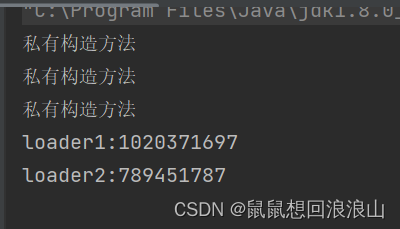
public class Singleton {
private static Singleton instance = new Singleton();
private Singleton() {}
public static Singleton getInstance(ClassLoader classLoader) {
synchronized (Singleton.class) {
if (instance == null) {
try {
Class<?> clazz = classLoader.loadClass(Singleton.class.getName());
instance = (Singleton) clazz.newInstance();
} catch (ClassNotFoundException | InstantiationException | IllegalAccessException e) {
e.printStackTrace();
}
}
}
return instance;
}
}
- 通过unsafe破坏单例:目前没有预防的方法。

总结:多线程破坏单例使用DCL+voliatle预防,反射破坏单例使用在构造方法处检查对象是否存在进行预防,实现序列化接口破坏单例使用实现readResolve方法,返回已经创建的单例对象。unsafe目前还没有预防的方式。
方式二:枚举类
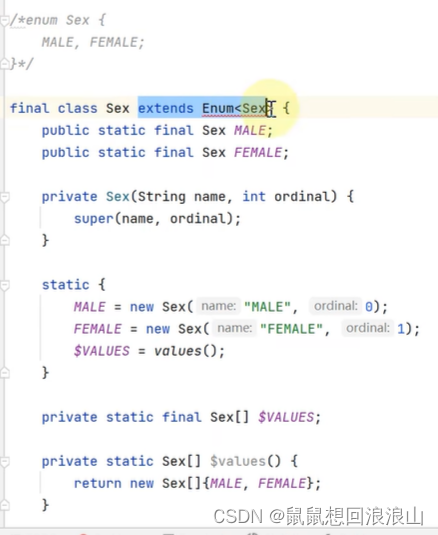
public enum Singleton3 {
INSTANCE;
private Singleton3(){
System.out.println("枚举类的私有构造方法");
}
@Override
public String toString() {
//getClass().getName()返回该对象的类名,Integer.toHexString(hashCode())返回该对象的哈希码的十六进制表示。
return getClass().getName()+"@"+Integer.toHexString(hashCode());
}
public Singleton3 getInstance(){
return INSTANCE;
}
public void otherMethod(){
System.out.println("其他方法");
}
}
测试: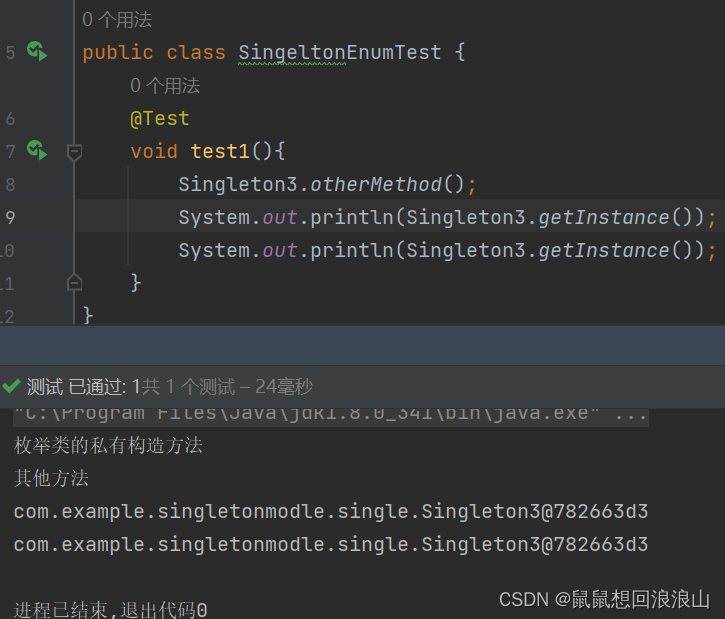
枚举实现的单例可以预防反序列化破坏单例
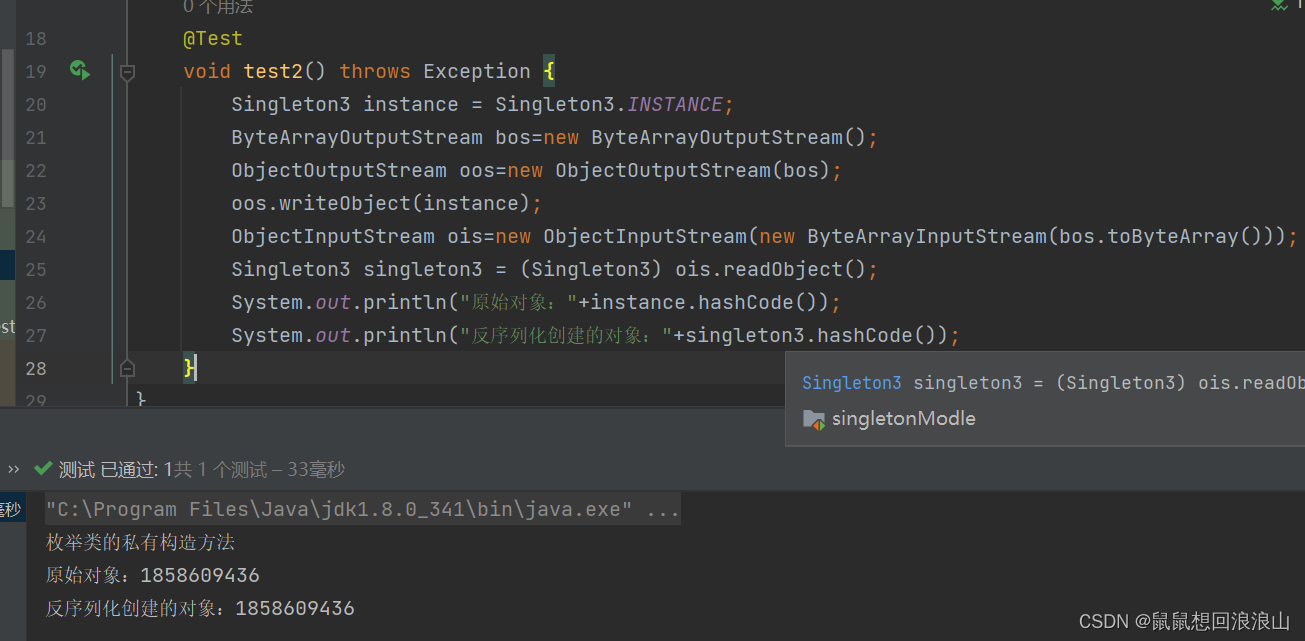
枚举也可以预防反射破坏单例

枚举类的构造方法不是无参构造,有两个参数。
但是枚举无法预防unsafe破坏单例模式。
方式三:懒汉式
//懒汉式
public class Singleton4 {
private static Singleton4 SINGLETON_TEST;
//构造私有
private Singleton4() {
System.out.println("私有构造方法");
}
public static Singleton4 getInstance(){
if (SINGLETON_TEST==null){
SINGLETON_TEST=new Singleton4();
}
return SINGLETON_TEST;
}
public static void otherMotherd(){
System.out.println("其他方法");
}
}
测试:
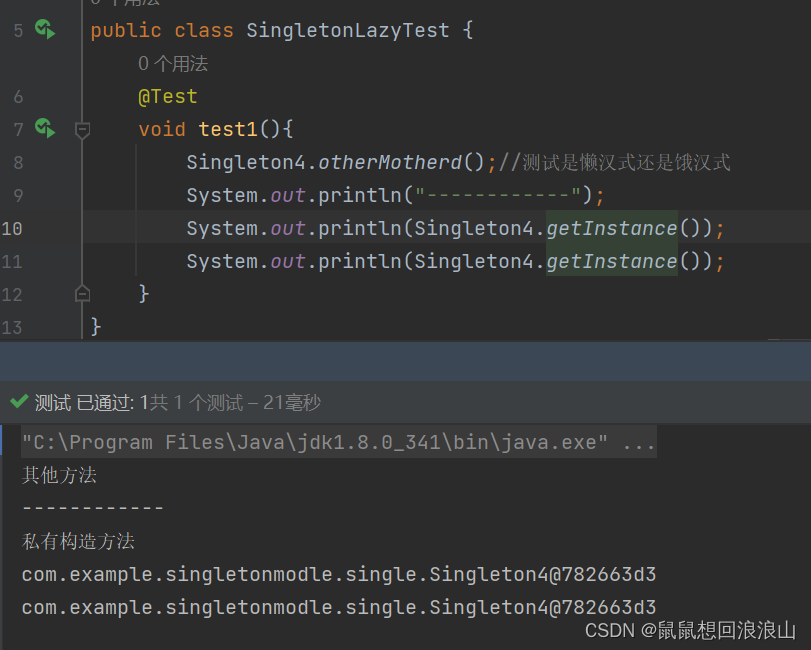
以上单例模式在多线程下存在单例被破坏的可能。
-
多线程环境下未处理好并发访问:
如果在多线程环境下,多个线程同时尝试获取单例实例,可能会导致创建多个实例的情况。可以使用DCL(双重检测来确保只有一个实例被创建,DCL需要配合volatile使用,确保可见性)。懒汉式
public class Singleton {
private static final Singleton instance = new Singleton();
private Singleton() {}
public static Singleton getInstance() {
return instance;
}
}
public class Main {
public static void main(String[] args) {
// 创建多个线程同时获取单例实例
Thread thread1 = new Thread(() -> {
Singleton singleton = Singleton.getInstance();
System.out.println("Thread 1: " + singleton.hashCode());
});
Thread thread2 = new Thread(() -> {
Singleton singleton = Singleton.getInstance();
System.out.println("Thread 2: " + singleton.hashCode());
});
thread1.start();
thread2.start();
}
}
预防:DCL+voliatle ,也就是第四种实现方式。
方式四:DCL+voliatle
public class Singleton {
private static volatile Singleton instance; //保证共享变量的有序性
private Singleton() {}
public static Singleton getInstance() {
if (instance == null) {
synchronized (Singleton.class) {
if (instance == null) {
instance = new Singleton();
}
}
}
return instance;
}
}


方式五:静态内部类,懒汉式:
/静态内部类方式
public class Singleton6 {
private static Singleton6 SINGLETON_TEST=null;
//构造私有
private Singleton6() {
System.out.println("私有构造方法");
}
private static class Holder{
static Singleton6 INSTANCE=new Singleton6();
}
public static Singleton6 getInstance(){
return Holder.INSTANCE;
}
public static void otherMotherd() {
System.out.println("其他方法");
}
}
JDK中单例的体现方式:
单例模式一般在jdk的一些库中见到,自己不要乱用单例模式,很容易用错。

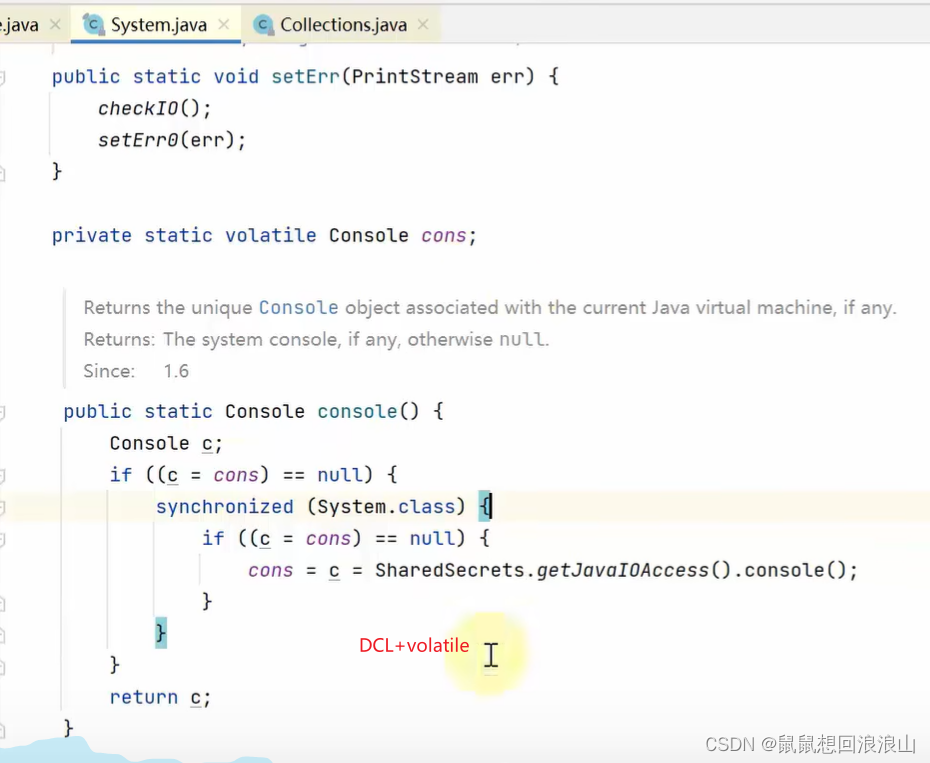





















 1007
1007











 被折叠的 条评论
为什么被折叠?
被折叠的 条评论
为什么被折叠?








